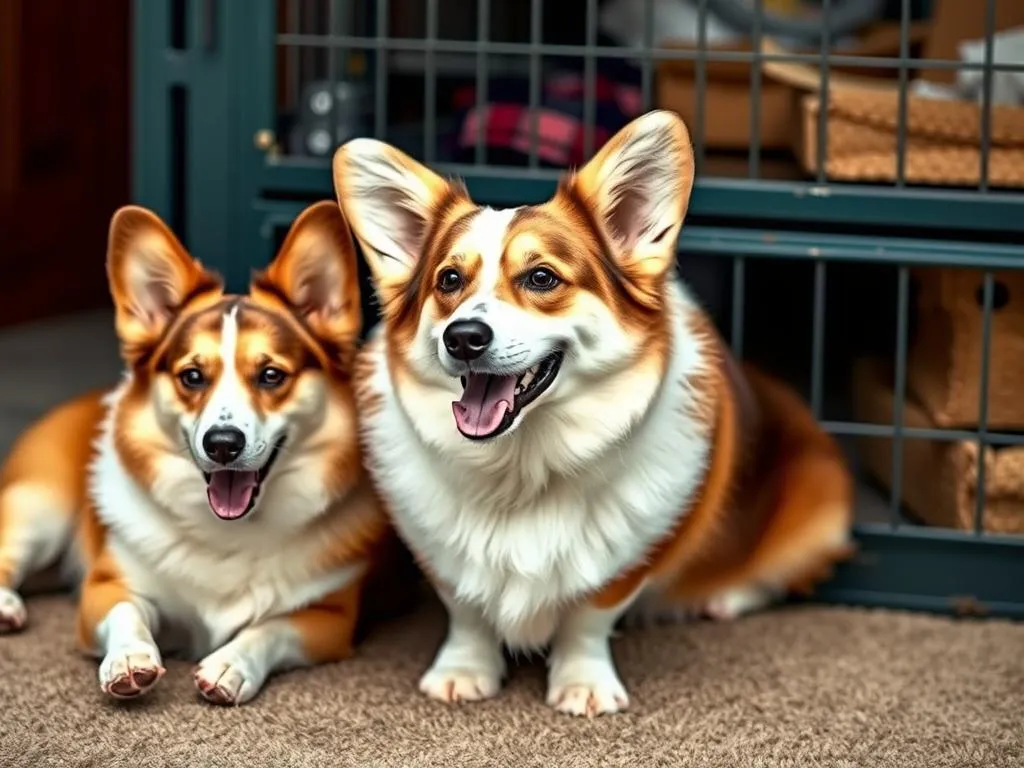
Introduction
Crate training is a crucial aspect of a dog owner’s journey, providing a safe and secure environment for their furry companions. For Corgis, known for their playful and energetic nature, selecting the right crate size is vital to ensure their comfort and well-being. This blog post aims to guide new Corgi owners, dog trainers, and pet enthusiasts in determining what crate size do Corgis need.
Understanding Corgis
Breed Characteristics
Corgis are a beloved breed, recognized for their unique appearance and charming personalities. The two primary Corgi breeds are the Pembroke Welsh Corgi and the Cardigan Welsh Corgi. While they share many similarities, there are notable differences in their characteristics:
- Pembroke Welsh Corgi: Typically weighs between 25 to 30 pounds and stands about 10 to 12 inches tall.
- Cardigan Welsh Corgi: Generally heavier, weighing between 25 to 38 pounds, and reaches a height of 10 to 12 inches.
Both breeds have a sturdy build, with a long body and short legs, which influences the crate size they require.
Behavior and Temperament
Corgis are known for their friendly and intelligent nature. They are alert, energetic, and often exhibit a playful demeanor. However, they can also display stubbornness, which may lead to challenges in training. Understanding their temperament is essential when considering crate training.
Creating a safe space is vital for Corgis, as it allows them to retreat and feel secure in their environment. A well-sized crate can help reduce anxiety and provide a den-like atmosphere, which is crucial for their emotional well-being.
The Importance of Crate Training
Benefits of Crate Training
Crate training offers numerous benefits for both dogs and their owners:
- Safe and Secure Environment: A crate provides a designated space where your Corgi can feel safe, especially during stressful situations like thunderstorms or fireworks.
- Aids in Potty Training: Dogs naturally avoid soiling their sleeping area, making crates an effective tool for teaching potty training.
- Reduces Anxiety and Destructive Behavior: A crate can help minimize anxiety and prevent destructive behavior when left alone, as it provides a controlled environment.
Common Myths about Crate Training
Many misconceptions surround crate training, leading to reluctance among dog owners. One common myth is that crating is cruel. In reality, when used correctly, a crate can be a positive space for dogs.
Understanding the purpose of a crate is essential; it should never be viewed as a punishment but rather as a safe haven where your Corgi can relax and feel comfortable.
Factors to Consider When Choosing a Crate Size
Corgi Size and Growth
When determining what crate size do Corgis need, it’s crucial to consider their size and growth patterns. Adult Corgis typically weigh between 25-38 pounds and reach a height of 10-12 inches. For puppies, it’s important to account for their growth stages. A crate that is too large may encourage them to use one end as a bathroom.
Crate Types
There are several types of crates available, each with its pros and cons:
-
Wire Crates: These provide good ventilation and visibility for your Corgi, making them feel less confined. However, they might not be as cozy in colder weather.
-
Plastic Crates: Offering more privacy, plastic crates can make your Corgi feel secure. They are also easier to clean but can be less spacious.
-
Soft-Sided Crates: Lightweight and portable, these are great for travel but may not be suitable for aggressive chewers.
Crate Size Guidelines
When selecting a crate, consider the recommended dimensions for Corgis:
- Length: Measure from the tip of the nose to the base of the tail (approximately 30 inches for adults).
- Width: Corgis should have enough room to turn around comfortably, requiring a width of about 18-24 inches.
- Height: Ensure there’s enough vertical space for your Corgi to stand up without hitting their head, approximately 22-26 inches.
To measure your Corgi correctly, use a tape measure and ensure they are standing naturally.
Adjustability and Expandability
As Corgi puppies grow, their crate needs will change. Consider investing in an adjustable crate with removable dividers. This allows you to customize the space as your puppy grows, ensuring they feel secure without having too much room.
Recommended Crate Sizes for Corgis
Puppy Crate Size
For Corgi puppies, an ideal crate size would be around 24 inches long, 18 inches wide, and 22 inches high. This size accommodates their growth while preventing them from using the crate as a bathroom. Transitioning to a larger crate can occur when your puppy reaches around 6 months of age.
Adult Crate Size
For adult Corgis, the recommended crate size is approximately 30 inches long, 24 inches wide, and 26 inches high. This size allows enough room for movement while providing a cozy space for relaxation. Popular crate models that suit Corgis include those from brands like MidWest, Petmate, and AmazonBasics, which offer various styles to meet your preferences.
Tips for Crate Training Your Corgi
Introducing the Crate
Introducing your Corgi to their crate can be a smooth process if done correctly:
- Familiarization: Allow your Corgi to explore the crate freely without force. Place it in a common area with the door open.
- Positive Association: Use treats or toys to encourage your Corgi to enter the crate. Reward them when they do so.
- Short Sessions: Begin with short periods in the crate, gradually increasing the time as your Corgi becomes more comfortable.
Making the Crate Inviting
To make the crate more inviting, consider adding:
- Bedding: Provide soft, comfortable bedding to create a cozy atmosphere.
- Toys: Include safe chew toys or interactive toys to keep your Corgi occupied.
- Treats: Use treats to encourage positive associations with the crate.
Establishing a Routine
Consistency is key in crate training. Establish a routine that includes:
- Regular Crate Time: Designate specific times for crate training, such as during meals or when you leave the house.
- Potty Breaks: Ensure your Corgi has regular potty breaks to prevent accidents in the crate.
Monitoring Behavior
Keep an eye on your Corgi’s behavior as they adapt to crate training. Signs of discomfort may include whining, barking, or excessive scratching. If you notice these behaviors, reassess the crate size and environment, and ensure they feel secure in their space.
Common Problems and Solutions
Anxiety and Resistance
Corgis may experience anxiety when first introduced to a crate. Signs include excessive barking or attempts to escape. To ease their anxiety:
- Gradual Introduction: Take your time with the introduction process, ensuring your Corgi associates the crate with positive experiences.
- Comfort Items: Place familiar items like blankets or toys inside the crate to provide comfort.
Potty Training Challenges
If your Corgi struggles with potty training in the crate, consider these tips:
- Frequent Breaks: Take your Corgi outside regularly, especially after meals and naps.
- Correct Size: Ensure the crate is appropriately sized; too much space can lead to accidents.
Destructive Behavior
If your Corgi begins to chew or scratch at their crate, it may indicate boredom or discomfort. To prevent destructive behavior:
- Interactive Toys: Provide toys that stimulate your Corgi mentally to keep them engaged.
- Regular Exercise: Ensure your Corgi receives sufficient physical activity to burn off excess energy before crate time.
Conclusion
Selecting the right crate size for your Corgi is essential for their comfort and well-being. Understanding their breed characteristics, growth patterns, and behavioral needs will help you make an informed decision. By implementing effective crate training techniques, you can create a positive environment for your furry friend, enhancing their overall happiness and security.
With patience and consistency, crate training can become a rewarding experience for both you and your Corgi, fostering a strong bond and a sense of trust.









